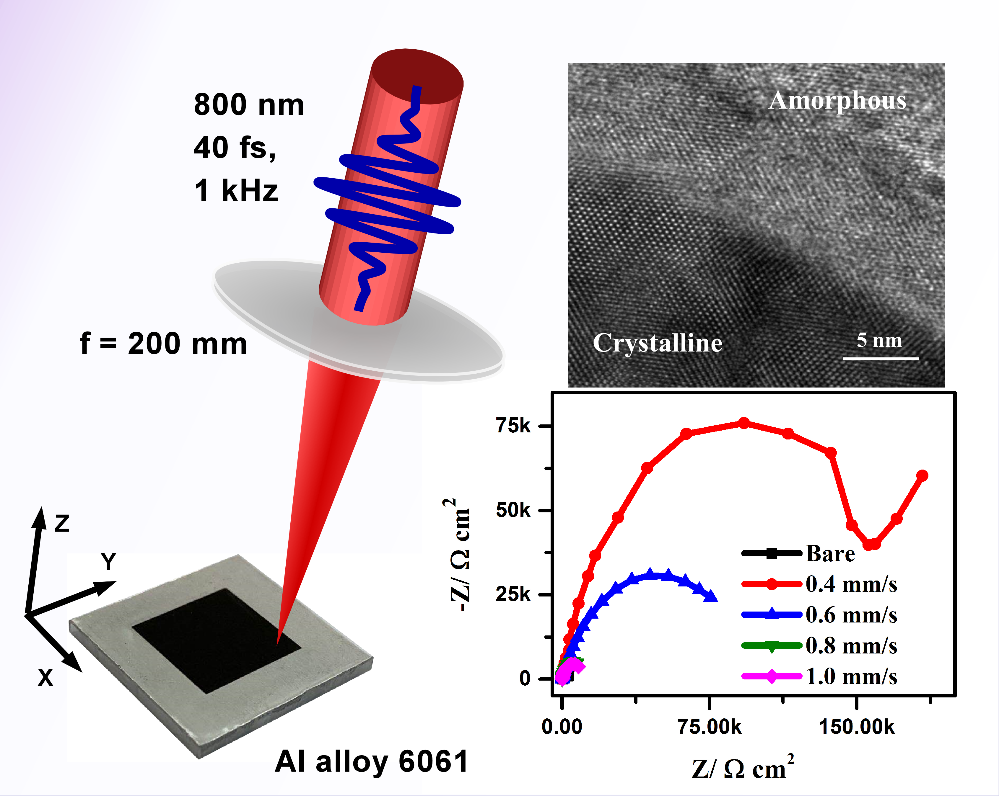Author: |
Editor: Rahul A. Rajan | Nov 17, 2021
Metal surfaces are vulnerable to pitting and peeling failures in deep seawater due to aggressive corrosive ions, which can hamper their usage for marine applications. Therefore, anticorrosion research on industrial metallic surfaces to avoid the seawater corrosive ion interaction has great life-saving and economic significance.
Recently, PhD student Rahul A. Rajan, Prof. YANG Jianjun and their collaborators from Changchun Institute of Optics, Fine Mechanics and Physics (CIOMP), Chinese Academy of Sciences (CAS) transform a seawater corrosive aluminium (Al) alloy (#6061) metal surface into the long-term stable anticorrosive through femtosecond laser-induced surface microstructures with the phase change from crystalline to amorphous. This study has been published in Applied Surface Science.
Such change in phase of the polycrystalline material can significantly diminish the well distinct grain boundaries and chemical inhomogeneities, these can be common nucleation sites for corrosion generation because they act as anodic spots while the surrounding metal matrix act as cathode.
Primarily, the whole surface of well-polished samples were irradiated with ultrashort laser pulses of around 40 fs duration and created complex micro/nano-structures at different scanning speeds. Then, they were annealed at 200°C to make the surface superhydrophobic, which can help repel seawater from the surface. The resultant sample surfaces were studied with electrochemical measurements in the seawater environment, which shows that the sample irradiated with more number laser pulses (at the scanning speed of V=0.4 mm/s) offers improved corrosion resistance (13.8 MΩ/cm2) than that of other scanning speeds and the bare sample (25.2 kΩ/cm2).
Most importantly, the seawater immersion test of these samples for more than two months confirms that the corrosion prevention efficiency of fabricated samples can reach as high as 99.13%. Researchers have investigated its underlying mechanisms by examining the laser-induced chemical composition and the crystalline lattice changes. They found that stable oxide layer formation and crystalline to amorphous phase transformation plays an important role to protect the sample surface for a long-term in corrosive environments like seawater.
Besides, intense laser ablation introduce significant dislocation densities in the crystal lattice arrangement, which decrease the overall free energy within the amorphized material, thus decreasing the reactivity of constituent elements by improving the chemical stability of the Al alloy. Therefore, the crystal lattice dislocations present in the amorphous material significantly increase the corrosion resistance and decrease the corrosion current flow between the galvanic pairs, which benefits to reduce the overall corrosion rate of femtosecond laser-irradiated metals surfaces.
In short, the anti-corrosion property of these ultra-short laser-irradiated samples can be attributed to: (i) surface nonwetting effect due to the micro air pockets on the surface structures, (ii) formation of thick stable metal oxide layers, (iii) material phase transformation from crystalline to amorphous. Through this study, researchers proved that the latter two are the major responsible reasons for the long-term corrosion protection behaviour. Eventually, this study has shed light on femtosecond laser processing for anticorrosive Al alloy surfaces, which can be extendable for other metal surfaces to improve their anticorrosion behaviour for construction, ship building and many other deep-sea applications.

Fig.1 Transform an Al alloy material into long-term stable anticorrosive by femtosecond laser induced microstructure with the phase change.
Contact:
Rahul A. Rajan
Changchun Institute of Optics, Fine Mechanics and Physics (CIOMP), Chinese Academy of Sciences (CAS)
E.mail: rahularaj1@mails.ucas.ac.cn
Article link: https://doi.org/10.1016/j.apsusc.2021.151612
